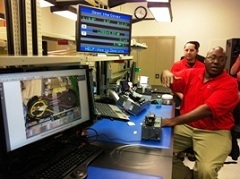- Home page /
- New technologies and equipment /
- Halliburton showcases new Pinnacle Applied Photonics...
Halliburton showcases new Pinnacle Applied Photonics facility
20.02.2013

Halliburton showed off its recently integrated Applied Photonics Center in north Houston via a media tour. The Applied Photonics Center offers, under one roof, a fiber-optic manufacturing testing and R&D capabilities to develop new solutions for real-time, downhole, logging and monitoring applications. Pinnacle’s photonics center is focused on both single point and distributed sensor technologies.
The facility includes a light and acoustics laboratory, fiber splicing equipment and a system assembly department. The high-technology equipment includes a special, high-powered laser welder that welds sensor pieces together, with a stronger bond than conventional welding.
“The photonics center was formed to leverage the many benefits that fiber optics have over traditional electronic instruments” said Carl Blanchard, Vice President for Production Enhancement. “In this multi-use facility, Halliburton is focused on a range of related disciplines from pure research for advancing the science of photonic sensing to engineering and packaging commercial solutions that our clients use to derive new value from their fields.”
Specific fiber-optics measurements include distributed temperature sensing (DTS) for downhole temperature profiling, distributed acoustic sensing (DAS) for vertical seismic profiling and distributed strain sensing (DSS) for pressure measurements. These systems can be used for applications such as stimulation monitoring.
Pinnacle’s fiber-optic systems offer an advantage over wire sensors, which rely on gravity to be positioned. Because the fiber-optic strands are bundled into what are essentially flexible rods, these fiber-optic lines can be inserted deep into long laterals, similar to coiled tubing. For Pinnacle’s distributed sensor systems, there is no need to attach external devices to the fiber as the strands themselves can directly relay information about pressure, temperature and vibration, to the surface.
Halliburton also used the media tour to introduce its newly appointed Vice President of Technology, Gary Powers, who has joined the oilfield after careers chemical and aerospace technologies. “We have to advance technology beyond what we’ve always been doing,” Powers said. “We want to develop disruptive technologies such as next-generation modeling and prediction capabilities, lasers to transmit power to downhole tools and nano-technology to instantaneously turn liquids to solids for applications such as reducing loss of circulation.”

